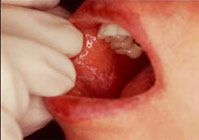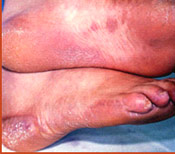


Lichen Planus Overview
 Lichen planus is a chronic mucocutaneous disease that affects the skin and the oral mucosa, and presents itself in the form of papules,lesions or rashes.
It is a recurrent rash that is due to inflammation. The rash is characterized by small, flat-topped, many-sided (polygonal) bumps that can grow together into rough, scaly patches on the skin. There may also be a rash in the lining (mucous membranes) of the mouth or vagina. It occurs characteristically on the wrists, shins, lower back and genitalia. Involvement of the scalp may lead to hair loss.
The major point of distinction of lichen Planus from eczema, psoriasis, and other common rashes is its color -- lilac or violet. The textbooks call it "violaceous."
The cause(s) of lichen planus are unknown.
Lichen planus is a chronic mucocutaneous disease that affects the skin and the oral mucosa, and presents itself in the form of papules,lesions or rashes.
It is a recurrent rash that is due to inflammation. The rash is characterized by small, flat-topped, many-sided (polygonal) bumps that can grow together into rough, scaly patches on the skin. There may also be a rash in the lining (mucous membranes) of the mouth or vagina. It occurs characteristically on the wrists, shins, lower back and genitalia. Involvement of the scalp may lead to hair loss.
The major point of distinction of lichen Planus from eczema, psoriasis, and other common rashes is its color -- lilac or violet. The textbooks call it "violaceous."
The cause(s) of lichen planus are unknown.
What are the causes of Lichen Planus?
Top
The cause of lichen planus is not known. It is not contagious and does not involve any known pathogen.
It can be associated with:
- Some lichen planus-type rashes (known as lichenoid reactions) can occur as allergic reactions to medications for high blood pressure, heart disease and arthritis. These lichenoid reactions are referred to as lichenoid mucositis (of the mucosa) or dermatitis (of the skin).
- Lichen planus has been reported as a complication of chronic hepatitis C virus infection.
- Stress
- Women are more affected than men
What are the sign and symptoms of Lichen planus?
Top
Lichen planus itches with an intensity that varies in different people from mild to severe.
The typical rash of lichen planus is well described by 5 P’s
Skin involvement: The usual skin involvement with lichen planus consists of flat-topped lilac or violet spots a few millimeters in diameter on the skin. These spots tend to be located on the inner wrists, forearms, the lower legs just above the ankles, and the lower part of the back.
 Mucous membranes: Lichen planus of the mucous membranes is common. Dentists often come across it as a white, lacy rash on the inside of the cheeks of people who are unaware of the condition. About half of the people affected with lichen planus have the rash inside of their mouths (oral mucosa). The oral rash often occurs prior to any skin involvement.
Mucous membranes: Lichen planus of the mucous membranes is common. Dentists often come across it as a white, lacy rash on the inside of the cheeks of people who are unaware of the condition. About half of the people affected with lichen planus have the rash inside of their mouths (oral mucosa). The oral rash often occurs prior to any skin involvement.
- The onset of lichen planus can be sudden or gradual. The first attack may last for weeks or months, and recurrences may happen for years. Children are not often affected by lichen planus. The bumps at first are 2 to 4 mm in diameter, with angular borders, and a violaceous color. Rarely, a patchy scarring balding (alopecia) of the scalp occurs.
The typical rash of lichen planus is well described by 5 P’s
- 1. Pruritic,
- 2. Planar,
- 3. Purple,
- 4. Polygonal
- 5. Papules.
Skin involvement: The usual skin involvement with lichen planus consists of flat-topped lilac or violet spots a few millimeters in diameter on the skin. These spots tend to be located on the inner wrists, forearms, the lower legs just above the ankles, and the lower part of the back.
- A variant of this disease is called hypertrophic lichen planus. This condition appears as thick, reddish-brown lesions that are covered with scales. These spots tend to be on the shins, but they can occur anywhere on the body. This is an especially itchy and persistent (chronic) variant of lichen planus.
 Mucous membranes: Lichen planus of the mucous membranes is common. Dentists often come across it as a white, lacy rash on the inside of the cheeks of people who are unaware of the condition. About half of the people affected with lichen planus have the rash inside of their mouths (oral mucosa). The oral rash often occurs prior to any skin involvement.
Mucous membranes: Lichen planus of the mucous membranes is common. Dentists often come across it as a white, lacy rash on the inside of the cheeks of people who are unaware of the condition. About half of the people affected with lichen planus have the rash inside of their mouths (oral mucosa). The oral rash often occurs prior to any skin involvement.
- More troublesome, although rare, is erosive lichen planus, which can be quite sore and uncomfortable. This erosive form typically causes the patient to complain of the shallow and often quite painful, recurrent ulcers in the mouth.
- Lichen planus can affect the female genitals, including the vagina. This condition can be confused with sexually transmitted diseases (STDs), although lichen planus is neither sexually transmitted nor contagious.
How is it Diagnosed?
Top
Usually, lichen planus is relatively straightforward to diagnose. Physicians can make the diagnosis in typical cases simply by looking at the rash.
If necessary, a skin biopsy may be done to help confirm the diagnosis.
What is the role of Homoeopathy in Lichen planus?
Top
As described in the article above Lichen planus has multifactor ail causes. Homoeopathy follows an individualistic approach towards patients suffering from Lichen planus we believe that every individual is different and thus a full in-depth case study is the first step. Then referring to the risk factors the individual was subjected too, a particular line of treatment is adopted. The usual conventional treatment provides only mere palliation or suppression. On the other hand our deep acting constitutional medicine cure the disease in depth rendering the patient free from the disease
A broad criterion of how the homoeopathic medicines act in cases of Lichen planus is mentioned below. The response to treatment can differ from one individual to another patients are advised to consult so that the mode of treatment can be discussed pertaining to their particular case
Relieves Symptoms like:
Controlling and reversing the underlying Disease process:
Our deep acting constitutional medicines work at the root level. Homoeopathy with its natural medicinal substances used in small quantities cures eczema inside out. Also it helps cure the predisposition of skin to have eczema.
We at DRSS provide our patients with diet charts, exercise schedules and guide them how to modify their lifestyle so that better results can be achieved.
Homoeopathic medicines if taken under proper guidance from a well-qualified professional are extremely safe and have no side effects.
A broad criterion of how the homoeopathic medicines act in cases of Lichen planus is mentioned below. The response to treatment can differ from one individual to another patients are advised to consult so that the mode of treatment can be discussed pertaining to their particular case
Relieves Symptoms like:
- Itching
- Skin lesions
- Dryness of skin
- Tenderness
- Removes scars and marks
Controlling and reversing the underlying Disease process:
Our deep acting constitutional medicines work at the root level. Homoeopathy with its natural medicinal substances used in small quantities cures eczema inside out. Also it helps cure the predisposition of skin to have eczema.
We at DRSS provide our patients with diet charts, exercise schedules and guide them how to modify their lifestyle so that better results can be achieved.
Homoeopathic medicines if taken under proper guidance from a well-qualified professional are extremely safe and have no side effects.

Lichen Planus




